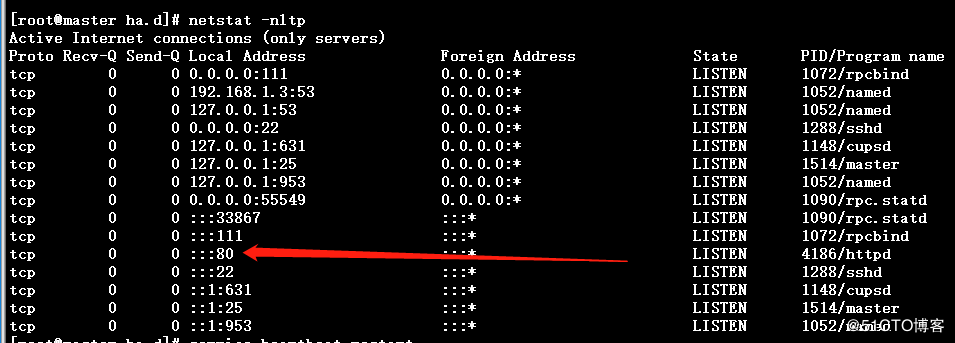一、前言
HA即(high available)高可用,又被叫做双机热备,用于关键性业务。简单理解就是,有2台机器 A 和 B,正常是 A 提供服务,B 待命闲置,当 A 宕机或服务宕掉,会切换至B机器继续提供服务。常见的实现高可用的开源软件有 heartbeat 和 keepalived
二、准备实验环境
服务器A:
主机名:master
操作系统:CentOS6.5 64位
eth0网卡地址:192.168.1..3
服务器B:
主机名:slave
操作系统:CentOS6.5 64位
eth0网卡地址:192.168.1.4
虚拟VIP:
VIP:192.168.1.2
三、设置主机名
A服务器
[root@localhost ~]# hostname master
[root@localhost ~]# vim /etc/sysconfig/network
HOSTNAME=master
B服务器
[root@localhost ~]# hostname slave
[root@localhost ~]# vim /etc/sysconfig/network
HOSTNAME=slave
四、关闭防火墙和Selinux(2台节点都要操作)
[root@localhost ~]# setenforce 0
[root@localhost ~]# service iptables stop
[root@localhost ~]# chkconfig iptables off
五、配置hosts文件(2台节点都操作)
[root@localhost ~]# vim /etc/hosts
192.168.1.3 master
192.168.1.4 slave
六、设置ssh互信(2台节点都操作)
[root@master ~]# ssh-keygen -t rsa -f ~/.ssh/id_rsa -P ''
[root@master ~]# ssh-copy-id -i .ssh/id_rsa.pub [email protected]
测试
[root@master ~]# ssh 192.168.1.4 'ifconfig'
七、安装epel扩展源 (2台都操作)
[root@master ~]yum install -y epel-release
八、安装heartbeat (2台都操作)
[root@master ~]# yum -y install heartbeat httpd
[root@slave ~]# yum -y install heartbeat httpd
八、配置时间同步(2台都操作)
[root@master ~]# date -s "2019-02-27“
2019年 02月 27日 星期三 00:00:00 CST
[root@master ~]# date -s "13:50:30"
九、配置httpd
[root@master ~]# echo "Master" > /var/www/html/index.html
[root@master ~]# service httpd start
[root@master ~]# service httpd stop
[root@master ~]# chkconfig httpd off
十、配置Heartbeat
1、拷贝三个配置文件
[root@master ~]# cd /etc/ha.d/
[root@master ha.d]# cp -r /usr/share/doc/heartbeat-3.0.4/{authkeys,ha.cf,haresources} ./
2、修改authkeys
[root@master ha.d]# vim authkeys
auth 1
1 md5 5t2dhlk6sdrf8dshnm3
更改authkeys的权限
[root@master ha.d]# chmod 600 authkeys
3、编辑haresources文件
[root@master ha.d]# vim haresources
master IPaddr::192.168.1.2/24/eth0:0 httpd
4、配置ha.cf文件
[root@master ha.d]# vim ha.cf
bcast eth0
node master
node slave
配置说明
debugfile /var/log/ha-debug:该文件保存heartbeat的调试信息。
logfile /var/log/ha-log:heartbeat的日志文件。
keepalive 2:心跳的时间间隔,默认时间单位为秒s。
deadtime 30:超出该时间间隔未收到对方节点的心跳,则认为对方已经死亡。
warntime 10:超出该时间间隔未收到对方节点的心跳,则发出警告并记录到日志中。
initdead 60:在某系统上,系统启动或重启之后需要经过一段时间网络才能正常工作,该选项用于解决这种情况产生的时间间隔,取值至少为deadtime的2倍。
udpport 694:设置广播通信使用的端口,694为默认使用的端口号。
bcast eth0 :通过eth0网卡进行向外广播
十一、把主节点上的三个配置文件拷贝到从节点
[root@master ~]#cd /etc/ha.d
[root@master ha.d]#scp authkeys ha.cf haresources slave:/etc/ha.d
十二、启动heartbeat服务
[root@master ha.d]# service heartbeat start
十三、切换至备机
必须远程启动备机的heartbeat
[root@master heartbeat]# ssh slave 'service heartbeat start'
[root@master ha.d]# cd /usr/share/heartbeat/
[root@master heartbeat]# ./hb_standby
如果想切换至主机则
[root@slave ~]# cd /usr/share/heartbeat
[root@slave heartbeat]# ./hb_standby
HA挂载NFS系统配置
准备一台NFS服务器
操作系统:CentOS7.5 64位
eth0网卡地址:192.168.1.5
主机名:localhost
[root@localhost ~]#mkdir /web/htdocs -pv
[root@localhost ~]#vim /etc/exports
/web/htdocs 192.168.1.0/24(ro)
[root@localhost ~]#yum -y install nfs* --skip-broken
[root@localhost ~]#systemctl start nfs
[root@localhost ~]#cd /web/htdocs/
[[root@localhost htdocs]#vim index.html
NFS server
[root@localhost ~]#systemctl start rpcbind
[root@localhost ~]#systemctl stop firewalld
[root@localhost ~]#setenforce 0
服务器(2台都操作)
[root@master ~]# mount 192.168.1.5:/web/htdocs /mnt
[root@master ~]# ls /mnt/
index.html
[root@master ~]# cat /mnt/index.html
NFS server
[root@master ~]# umount /mnt/
[root@master ~]# cd /etc/ha.d/
[root@master ha.d]# vim haresources
master 192.168.1.2/24/eth0:0 Filesystem::192.168.1.5:/web/htdocs::/var/www/html::nfs httpd
[root@master ha.d]# scp haresources slave:/etc/ha.d/
[root@master ha.d]# service heartbeat start
[root@master ha.d]# ssh slave 'service heartbeat start'
验证是否可以访问
设置master为备机
[root@master ha.d]# cd /usr/share/heartbeat/
[root@master heartbeat]# ./hb_standby



